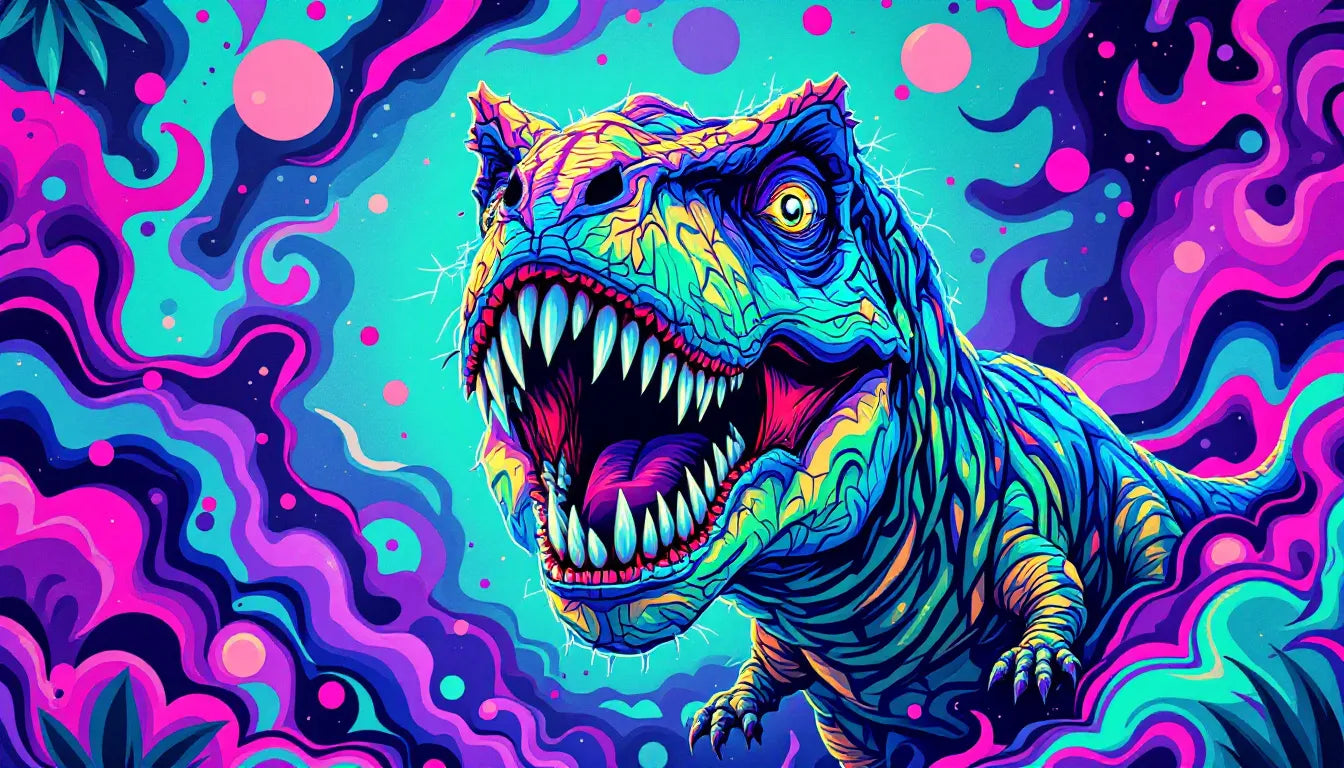- 🍄 Psilocybin-producing fungi date back at least 66 million years, meaning they coexisted with dinosaurs.
- 🧠 Terence McKenna’s Stoned Ape Theory suggests psychedelics played a role in early human cognitive evolution.
- 🌿 Some scientists believe psilocybin evolved as a defense mechanism to deter consumption or alter predator behavior.
- ⚠️ The rise of psychedelic commercialization and microdosing sparks ethical concerns about their misuse.
- 🔍 Studying the ancient history of psychedelics can provide insights into their potential benefits and responsible usage.

Dinosaurs and Psychedelics: A Wild Connection?
Psychedelics have a complex and fascinating history, dating back millions of years. While their influence on humans is well-documented, new research raises intriguing questions about whether psychedelic fungi existed during the age of the dinosaurs. Could these ancient creatures have been exposed to mind-altering substances? Moreover, as psilocybin persisted through evolutionary history, did it play a role in shaping intelligence? From its origins in prehistoric ecosystems to its possible influence on early human evolution, psychedelics may have a deeper evolutionary significance than previously thought.

Did Dinosaurs Encounter Psychedelic Fungi?
Fungi are some of the oldest life forms on Earth, with fossil evidence suggesting they predate plants and animals. Because psilocybin-producing fungi have been dated back to at least 66 million years ago, they likely existed alongside dinosaurs. But did dinosaurs actually consume them?
Though no direct evidence exists, it’s plausible that dinosaurs encountered psychedelic fungi in their natural environment. Many modern animals, from reindeer to jaguars, are known to consume psychoactive substances, either intentionally or inadvertently. If prehistoric herbivores or omnivorous dinosaurs grazed in areas where psilocybin mushrooms thrived, they may have ingested hallucinogenic compounds—potentially leading to altered behaviors.
Another possibility is that psilocybin evolved as a biological defense mechanism. Some researchers propose that certain fungi produce psychoactive compounds as a way to deter consumption, either because the resulting hallucinations are unpleasant or because they impact predator behavior in unpredictable ways. While this remains speculative, it adds a new layer to our understanding of prehistoric ecosystems.

The Evolution of Psilocybin: How Old Are Magic Mushrooms?
Psilocybin-containing mushrooms belong to the genus Psilocybe, which is thought to have evolved more than 66 million years ago—around the time of the Cretaceous-Paleogene extinction event. This means that psychedelic fungi not only appeared during the reign of dinosaurs but also survived and evolved through catastrophic global changes, including drastic shifts in climate and the rise of mammals.
Genomic studies suggest that psilocybin mushrooms developed their unique psychoactive properties through horizontal gene transfer, a process in which fungi exchange genetic material to adapt to their environments. Some scientists believe this means psilocybin played a functional role in ancient ecosystems, influencing the behavior of animals exposed to these fungi.
Additionally, certain fungi and plant species are known to form symbiotic relationships with the environment. For example, mycorrhizal fungi form partnerships with tree roots, facilitating nutrient exchange. Could psychedelic mushrooms have played a similarly vital role in prehistoric soil ecosystems? If so, their influence may have extended beyond individual animal encounters, shaping early ecosystems in ways yet to be fully understood.

The Stoned Ape Theory: Could Psychedelics Have Accelerated Human Evolution?
One of the most debated theories in psychedelic history is Terence McKenna’s Stoned Ape Theory, which suggests that early hominins consuming psychedelic mushrooms may have experienced accelerated cognitive development. According to McKenna, psilocybin’s effects—enhancing neuroplasticity, pattern recognition, and creativity—could have provided an evolutionary advantage for early humans by improving communication skills, problem-solving abilities, and social bonding.
While this theory remains highly controversial, recent discoveries in neuroscience lend some credibility to the idea that psychedelics can promote neural growth and adaptive learning. Studies have shown that psilocybin increases connectivity between different regions of the brain, temporarily dissolving rigid thought patterns and fostering creative problem-solving.
However, mainstream evolutionary scientists argue that intelligence and language development arose from a complex web of factors, including changes in diet, brain size, social organization, and tool-making abilities. While psychedelics could have been part of this process, they were unlikely to be the sole driving force behind human evolution.

Psychedelics as a Cognitive Catalyst: The Sorcerer’s Apprentice Dilemma
The idea that psychedelics can enhance cognition and creativity is not new, but it comes with potential downsides—what some call The Sorcerer’s Apprentice Dilemma. This metaphor, derived from folklore, describes a scenario where someone gains access to powerful tools but lacks the wisdom to use them responsibly.
This dilemma is particularly relevant in today’s psychedelic renaissance. While substances like psilocybin show great promise in treating depression, PTSD, and anxiety, their misuse—whether through unregulated self-experimentation or commercial exploitation—can lead to unintended consequences. For example, casual psychedelic use without proper guidance may result in psychological distress, delusions, or an overinflated sense of spiritual enlightenment.
Moreover, some critics argue that reducing psychedelics to a mere productivity tool—such as in the case of microdosing for work performance—ignores their deeper transformative potential. Historically, indigenous cultures used psychedelics in ritual settings designed for introspection and healing. The modern push to frame them as "smart drugs" risks stripping away their historical and spiritual significance.

Psychedelics in the Modern Age: Enhancing or Distorting Human Potential?
The resurgence of psychedelic research has reignited debates about their role in society. Should psychedelics be used solely as medical treatments? Are they tools for self-exploration? Or should they be approached with extreme caution due to their potential for misuse?
On one hand, studies indicate that psychedelic-assisted therapy can help treat mental health conditions like depression and substance-use disorders. Psilocybin has been found to foster emotional breakthroughs and promote long-term cognitive flexibility, making it a promising tool for psychotherapy.
On the other hand, the commercialization of psychedelics raises concerns. With increasing interest from mainstream industries, some worry that the movement will follow the path of cannabis—where corporate exploitation leads to mass production, diminishing indigenous wisdom and ethical considerations.
The conversation about psychedelics today reflects a broader philosophical question: Are these substances catalysts for healing and innovation, or could they distort reality and lead to another wave of consumer-driven escapism? As psychedelics become more widely accessible, societies must strike a balance between embracing their benefits and mitigating their risks.
Final Thoughts: What We Can Learn from the Past
Understanding the deep evolutionary history of psychedelics—from their ancient existence alongside dinosaurs to their possible role in human cognition—can provide valuable insights into their responsible use today. While it’s thrilling to imagine dinosaurs inadvertently tripping on psilocybin mushrooms, the more pressing discussion concerns how humans interact with these substances moving forward.
Historically, psychedelic use has been rooted in reverence, ritual, and healing. As modern science validates their benefits, it’s crucial to integrate them into society ethically. This means preventing reckless commercialization, ensuring proper education, and respecting indigenous traditions that have long understood their power.
Psychedelics have shaped natural history for millions of years. Whether they influenced dinosaurs in prehistoric times or enhanced human cognition in ancient tribes, their impact is undeniable. Now, it's up to us to use this knowledge wisely.
FAQs
Did prehistoric creatures like dinosaurs have encounters with psychedelic fungi?
There is no direct evidence, but psilocybin-producing fungi existed around the time of the dinosaurs, making it possible.
How far back can we trace the origins of psilocybin-producing fungi?
Recent genomic studies suggest psilocybin-producing fungi evolved approximately 66 million years ago.
What does the latest research suggest about the timeline of psilocybin evolution?
Studies indicate that psychedelic mushrooms emerged alongside the rise of mammals, possibly influencing early animal behavior.
How does this timeline align with the Stoned Ape Theory?
The emergence of psilocybin mushrooms predates human evolution, lending plausibility to the idea that early hominins encountered psychedelic fungi.
Does the psilocybin-mammal connection provide new perspectives on human evolution?
It suggests that psychedelic fungi could have played a role in shaping cognition, though human evolution depended on many other factors.
What parallels exist between the cautionary tale of The Sorcerer’s Apprentice and modern psychedelic use?
Like the apprentice who misuses powerful magic, unchecked psychedelic use could lead to unintended or harmful consequences.
Could psychedelics be an evolutionary catalyst, or do they pose risks of misuse?
They have potential cognitive benefits, but without careful regulation, there is a risk of commercial exploitation and misuse.
What role does the commercialization of psychedelics play in shaping the conversation around their use?
It can lead to broader accessibility but also risks commodifying psychedelics and diluting their therapeutic and spiritual value.
For more on psychedelics and their evolutionary history, check out DoubleBlind's coverage.



